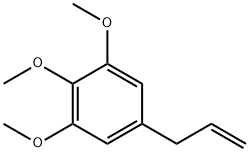Description
Elemicin is a trioxygenated phenylpropane that has been found in
A. dracunculus. It is active against
S. aureus,
B. subtilis, and
C. albicans (MICs = 600, 2,500, and 1,000 mg/L, respectively) but not
E. coli,
K. pneumoniae,
P. aeruginosa (MICs = >8,000 mg/L for all), or
L. monocytogenes (MIC = >3,000 mg/L). Elemicin is toxic to mice following metabolic activation to 1’-hydroxyelemicin by the cytochrome P450 (CYP) isoforms CYP1A1 and CYP1A2. It increases plasma and hepatic triglyceride levels, decreases stearoyl-CoA desaturase 1 (
Scd1) expression, and induces hepatomegaly in mice when administered at a dose of 500 mg/kg per day for three weeks.
Synthesis
Prod. :
1) by isolation from Elemi oil (high-boiling
fractions).
2) from Dimcthylpyrogallol plus Allyl bromide,
via 2,6-Dimethyl pyrogallol allylether.
This is heated in a Claisen-rearrangement
reaction to yield 4-Hydroxy-3,5-dimethoxy
allylbenzene. The latter is methylated to
yield Elemicine.
3) From Eugenol via 5-Hydroxyeugenol.




